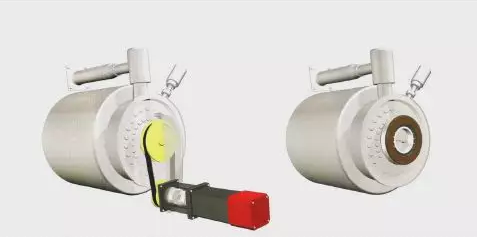Direct drive technology uses high-thrust torque motors or linear motors to replace the original gear drive, worm gear, ball screw drive, electrical drive instead of mechanical drive. The emergence of direct drive technology has a history of hundreds of years. In recent years, it has been widely used in intelligent manufacturing and operation control, mainly including machine tools, semiconductors, laser processing, 3C electronics, lithium batteries and other industries.
In recent years, the domestic direct drive industry has developed rapidly, and its market applications have become more popular. This is due to the overall transformation and upgrading of the manufacturing industry. The core competitiveness of equipment manufacturing enterprises is innovation, and innovation-driven development is also one of the ways for equipment manufacturing enterprises to promote the transformation of intelligent manufacturing. The direct drive system is one of the hot spots in the development of the motion control market in recent years. Its product technology is an overall system project that covers multiple sub-fields such as linear motors, torque motors, driver modules, and sensors.

Direct drive motors are popular in the machine tool industry
Due to the simple transmission mechanism of linear motors, the problem of interpolation lag is reduced. Positioning accuracy, reproduction accuracy, absolute accuracy, and feedback control through position detection are all higher than "rotary servo motors and ball screws" and are easy to implement. Linear motor positioning accuracy can reach 0.1μm.
The CNC machine tool servo system composed of traditional rotary motors has many parts and complicated operations. Generally, the servo motor + bearing + coupling + screw + constitutes the supporting structure of the system. Such a system has a large inertial mass. The improvement of dynamic performance has been greatly restricted. The elastic deformation, friction loss and difficulty of parts produced during the movement process are difficult to eliminate, and this disadvantage will become more and more prominent as the use time increases, resulting in positioning lag and nonlinear errors, which seriously affects the machining accuracy from the hardware .
In recent years, the almost ideal feed transmission method of permanent magnet linear synchronous motor (PMLSM) has gradually replaced the traditional rotary motor and has developed rapidly. It breaks the traditional "rotary motor + ball screw" transmission mode and achieves "zero transmission". Through the electromagnetic effect, the electrical energy is directly converted into linear motion without any intermediate mechanism. It eliminates the disadvantages of moment of inertia, elastic deformation, backlash, friction, vibration, noise and wear, which greatly improves the speed of the servo system Responsiveness and control accuracy.
Compared with traditional industries, direct drive technology has very natural advantages, such as high accuracy (accuracy depends directly on control technology and sensing technology), fast speed (linear motors can reach 100m / min, torque motors can reach 500rpm) No wear (no mechanical wear), no gap (no mechanical physical clearance), excellent stress state (regional output, no point contact and line contact stress links), etc., can be well applied in the machine tool industry, and vigorously promote Development of the machine tool industry.
Main advantages of direct drive motors in machine tools
The machine tool feed system uses linear motor direct drive and rotary motor drive to move. The biggest difference between them is the elimination of all intermediate transmission links from the motor to the table. This kind of transmission method is called "direct drive", commonly known as "linear drive", also known as "zero drive". This "zero transmission" approach has brought performance indicators and advantages that the original rotary electric motor drive method could not achieve, but also brought new contradictions and problems.
With the development of direct drive technology, the comparison between the drive method of linear motor and traditional "rotary servo motor, ball screw" has attracted the attention of the industry. Compared with rotary motors, linear motors have no rotary motion and are not affected by centrifugal forces. Therefore, the speed of the linear motor can be very high, and the speed is convenient, which is suitable for high-speed applications.
The linear motion of the linear motor is adopted. Due to the characteristics of fast response and high accuracy, the motion mechanism has been successfully used for computer-controlled precision turning and grinding of special-shaped workpieces. Compared with the traditional method of processing profiled inner and outer contours by "die-casting", it has the characteristics of flexible programming modification and high machining accuracy, which is very suitable for the processing of multi-variety and small-batch products.
The linear motor replaces the traditional motor-screw system, which eliminates a series of links that affect accuracy, speed and dynamic performance, such as errors, clearances and speed restrictions brought by the mechanical transmission chain. It enables direct coupling between the motor and the load. Speed, high acceleration, high load positioning accuracy, fast cycle and other advantages, can obtain high dynamic performance, and the structure is simplified and compact, has become the application point of high-end CNC machine tools, high speed, high acceleration direct drive system in processing Centers, CNC milling machines, lathes, grinders, conforming processing machines, laser processing machines and heavy machine tools are widely used. These machine tools will play a special role in aviation, automotive, mold, energy, general machinery and other fields.
Direct-drive motor boosts machine tool performance
Due to the rapid development of automatic control technology and microcomputers, higher requirements are placed on the positioning accuracy of various automatic control systems. The biggest pain point in the field of traditional machine tools is that the transmission chain from the motor as the power source to the working parts passes through intermediate transmission links such as gears, worm gear pairs, belts, screw pairs, couplings, and clutches. Problems such as rotational elastic deformation, backlash, motion lag, friction, vibration, noise, and wear
With the development of the industry, the precision and high-speed machining requirements of CNC machine tools continue to increase, and the machine tools are gradually developing in the direction of high precision, high speed, composite, intelligent, and environmental protection. As a result, the concept of "direct drive" appeared. In the application of CNC machine tools, linear motors often act as a feed unit to drive the tool or table feed. The performance analysis indicators of the pointing servo system mainly focus on four aspects: response speed, stability, stiffness, and anti-interference ability.
With the development of motors and their drive control technology, and the increasing maturity, the concept of "direct drive" has gradually become a reality. The application of linear motors and their drive control technologies to the feed drive of machine tools has made the drive structure of machine tools appear. Major changes and a new leap in machine performance. For example, the American CincinnatiMilacron company produced a HyperMach large high-speed machining center for the aviation industry. The linear feed uses a linear motor with a shaft stroke of up to 46m, a rapid table travel of 100m / min, and an acceleration of 2g. It takes only 30 minutes to process a large thin-walled aircraft part on this machine tool; while the same part is processed on a general high-speed milling machine, which takes 3 hours; processing on an ordinary CNC milling machine, takes 8 hours, the advantages are quite obvious.
The development of linear motors and high-speed machine tools can be expected in the future
With the continuous innovation of linear motor manufacturing technology, the scale of production, and the decline in the price of permanent magnet materials and electronic products, the cost of linear motors is decreasing at a rate of 20% per year, especially in CNC machine tools, semiconductor integrated equipment and other machinery. The performance is more obvious, which provides a space for rapid growth of direct drive technology, and it has a broad application prospect on machine tools. But this application is new after all. Whether it is the linear motor itself or the matching numerical control technology, the potential is great. China is a big manufacturing country, and there is still a long way to go to develop high-end CNC equipment. The road is a long way to go, and I will search up and down. Only by truly mastering the core technology can linear motors help the machine tools take off further.





